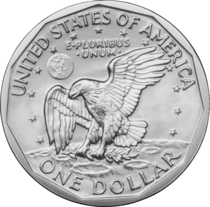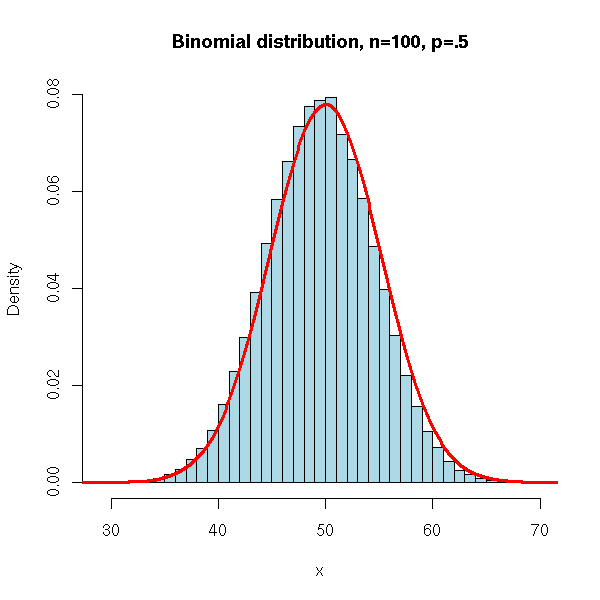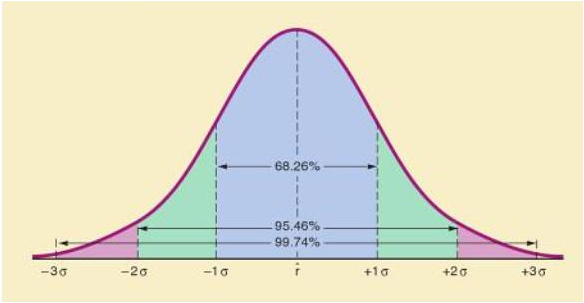How hard is it going to be ? Part 2
Let's talk probabilities for a moment. We have a little more to learn about risk before we can evaluate the merits of different strategies.The probability of a coin flip is 0.5 for Heads or Tail. In plain English, that means the coin is equally likely to fall on Heads as it is to fall on Tails.Because the probability is the same for every outcome, it doesn't matter if you were to bet on heads for 100 bets or on tail for 100 bets or any sequence of Heads and Tails.
In fact, because each coin flip is independent of the previous flip, you could even choose all your bets in advance and then flip the coin 100 times.Assuming that the bet pays even money, your expected payout for each bet is e = 0.5 * 2 = 1 that is, the expected payout on average is the probability of a win times the amount of the outcome.
Standard deviations or How far does the apple fall from the tree ?
The next important question to answer when playing this sort of game is: how far from my original capital will I be after N bets ?
The answer has two components:
- First you have to figure out what the highest probable outcome is.
- Second, is how far will my outcome be from the highest probable outcome ?
So for the coin flip, on average, your expected outcome is that after betting $1 on each bet you would expect to end up with $100. In other words, you expect to end up right where you started. This makes sense because after all, you expect to guess the right way only 1/2 the time, because the probability of the coin flip is 0.5 and you're not psychic.
If this is hard for you to visualize, just imagine you picked all the bets in advance. The coin doesn't 'know' what you chose and it is equally likely to fall on either side.
So any sequence of pre-selected bets is as likely as any other. In fact, although it is very counter intuitive, most people would never bet all head or all tails because they 'feel' that outcome is very unlikely.
The problem with this is that any other sequence you pick also has the same probability. Your brain is tricking you into thinking the all-heads and all-tails are different from other sequences because you can recognize these sequences better.
To answer the second question we need to talk about standard deviation.
Standard Deviation
If you try to estimate how far from your starting capital you will be after one bet, the answer is easy: either I'm up a dollar or down a dollar. So the deviation from my original bankroll is $1.
After two bets, the answer is a little more complicated, because I have to average things out. The possible outcomes are: (-$2, 0, +$2). But each outcome isn't as probable as the other, as there are two ways to get $0: (-1,+1) and (+1,-1) whereas there is only one way to get -$2 or +$2. You have to multiply each outcome by its probability to get the right answer: (-$2 \times 0.25) + ($0 \times 0.5) + (+$2 \times 0.25) = $0.
[Note that we're multiplying -2 and +2 by the overall probability they occur, which is 0.25 because out of 4 outcomes, each corresponds to only one, whereas 0 is multiplied by 0.5 because it corresponds to 2 outcomes.]
With more repeated bets it is easy to see that the answer will always be the same, because of the symmetry. There are as many chances that you win X as there are that you lose X, and these outcomes cancel each other out in the sum.
But what is the expected distance from that break-even outcome ?
That's not because of the symmetry,
If we square each difference, making the negative ones positive, we can get a better idea of how 'far' the outcomes are from the mean.
What does this really tell us ?
It's hard to make sense of this number with so few bets. But if you were to play the game for n bets, the histogram for the probability of each outcome would start to look like this:
and the distance from the break-even outcome would increase. It makes sense, because the longer you play the higher the chance you won't actually break-even.
It is easier to describe it in terms of success versus failure rather than to introduce the money within the formulas, because that way you can change the payout on wins and losses without having to re-calculate things.
[The reason this figure shows the highest value is at n/2 for n bets is because we're counting the outcomes, not the money, and 50 wins out of 100 trials is like breaking even in our little flip-a-coin game.]
What this curve shows is the probability of each outcome. It is called the Binomial Probability Distribution.
It turns out you can calculate the mean and standard deviation for this distribution for any n:
Starting with $100 after a hundred bets you should on average end up with
In terms of money, this turns out to $10.
Now that we know how the standard deviation is computed it's time to talk about how it is interpreted.
The Normal Distribution
For a very large number of bets, as the number of bets approaches infinity, the Normal Distribution approximates the Binomial Distribution.
This is handy because we don't want to have to figure out the Binomial distribution for a large N if we can get a nice formula for the Normal Distribution, which will give us close enough values for it.
You can see that the function is defined in terms of the mean
and the standard deviation
If you were to play many games in which you repeatedly bet 100 times and you were to plot the number of times you end up with a specific amount at the end of the game, you would essentially be playing the original game, with the same average but with more dispersion each time,
So we could calculate the normal distribution for a series of these games as well.
What is cool about the Normal Distribution is that the area under the curve is equal to 1. It accounts for all possible outcomes, and the simplest way to choose a scale that lets us compare different games with different standard deviations is to scale the area under the curve so it adds up to 1.
From the above figure, you can see that the probability of ending up with an outcome within one standard deviation from the mean is 68.26%.
For 200 games, the probability that you will not lose more than $28, but not win more than $28 is 95.46%.
































That system you used is called the martingale. It's definitely a bad idea unless you don't care to lose all you have at stake.
Congratulations @jdbertron! You have received a personal award!
Click on the badge to view your own Board of Honor on SteemitBoard.
For more information about this award, click here